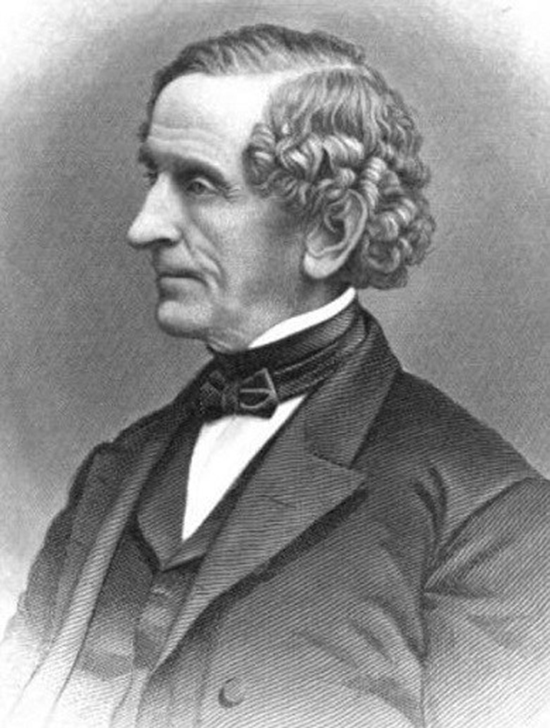In 1830s America, it seemed like Zachariah Allen was everywhere in Rhode Island. He was setting up the first private library, establishing the first mutual insurance company for manufacturers, and designing new fireproof textile mills. He led efforts to build public water systems throughout the city of Providence, a fire department, and free public schools. For his textile mills, he sought to create towns that would bring out the best in his workers. For Providence and its little state of Rhode Island, this one man left us many of the things that make the state a wonderful place, and his stately home is now the Faculty Club of Brown University, of which he was a proud alumnus and board member.
But one of Allen’s contributions has been hardly remembered because it’s been sitting idle for decades, after functioning remarkably for 80 years. As the owner of two major water-powered textile mills on the modest 50-square mile Woonasquatucket River watershed across town from his home, Allen faced a serious problem in utilizing all the thousands of spinning machines and legions of workers he hired: He needed water to reliably turn the machines.
During dry months, the Woonasquatucket turned from a torrent into a trickle. While there is ample rain to feed the river from November to May, some summers experienced extended droughts. Some years the mills were idled for weeks, and Allen and his fellow mill owners had to lay off their workers, or cut their pay. His detailed personal papers, preserved in boxes and files at the Rhode Island Historical Society that he also co-founded, reveal his obsession with production, waste, and costs. Handwritten and carefully folded pages have titles like “Loss of Operation at Georgia and Allendale Mills for Want of Water” and include detailed calculations of the number of gallons needed to flow over the water wheels in order to turn the gears and belts to keep his workers busy.
Rather than take the want of energy as an unresolvable problem, Zachariah Allen set out to solve it. He realized he’d have to re-plumb the whole watershed.
First, he raised the dam at his Georgia mill by three feet, boosting its storage capacity. But that was far from enough: The new height provided just five days of buffer for keeping the mill running. So he moved far upstream almost to the Woony’s headwaters. Beginning in the 1820s and 1830s, Allen led a group of mill owners up and down the river to build reservoirs on former fields and marshes, and bought privileges to draw down other existing mill ponds during dry months. In total, the cost was just $42,195, what would be about $1.1 million today.
After 10 years of experimenting, the group developed a careful plan of storing up the winter snowmelt and the spring rains, and then starting in late May beginning to draw down the reservoirs about nine inches per week. The detailed scheme worked for decades: In many years, the mills didn’t sit idle at all. In a few years, there were stoppages of a couple weeks. One year, they finished emptying the main reservoir in the evening of November 1, and the rains began that same night.
The six reservoirs, with a total of 4,928 acre-feet of water that could be carefully released as needed, provided all the mills downstream 84 days reliable supply of energy, regardless of whether the rain fell during those summers or not. This is a remarkable achievement: On a modest river, Allen had essentially created grid storage of 84 days capacity for everyone downstream. One scribe for the group two decades later proudly scribbled at the bottom of a page of calculations near the end of the bound ledger book with daily records of water levels in the Waterman and Slack Reservoirs:
“N.B.: It appears by a list of the mills and the number of people employed therein on the Woonasquatucket river in the year 1820, and at the present time [1848], that 1,600 more persons now get their living thusly, being over 1 percent of the population of Rhode Island.”
What we need now
What Allen created is precisely the kind of systems we need now to level off the supply and demand of electricity from wind, solar, and other renewable sources, as a way to provide “on demand” power when energy use peaks.
Even under the current fossil-fueled systems, afternoons in the summer can be the greatest choke point for electricity in the United States. The cost of electricity can soar to 600 times its usual price, as demand exceeds supply and grid operators have to purchase juice from highly polluting “peaker” coal, oil, and diesel plants and other expensive sources that are kept around only for those times. Economically the impact is great: This spike in costs for six peak hours on just 5-10 days a year can account for one-third of the price of electricity over the whole year. By burning the dirtiest fuels, it also sharply worsens air quality alerts on those days, precisely when smog formation is worst. Peaks in electricity demand also create a higher frequency of brownouts or blackouts.
Even in our current natural gas and coal-dominated electricity grids, providing on-demand “dispatchable” power for peak times is worth gold. With the science telling us that we need to quickly get off fossil fuels to avoid the risk of climate change and bad air quality, dispatchable power based on renewable energy is worth platinum.
To many observers’ surprise, wind power is sweeping the western U.S., as prices plunge and reliability increases. With enough turbines spread over a greater area, problems of intermittency are being reduced. Solar capacity is soaring across the country and is greatest precisely when needed the most, during those hot, sunny days when air conditioners are running full out. But there remains a certain level of intermittency issue and demand late in the afternoon that “grid storage” would address. Batteries are great, and they’re catching on, but they are expensive, and their price still needs to drop further to be affordable at grid scale. Other solutions like flywheels and pushing rail cars uphill are promising but raise scale and cost issues.
That’s where Allen’s ideas should be built upon. A new innovation, suppliers of wind power are pairing their facilities with dispatchable hydropower. In this way, they can guarantee power to utilities at quite a low cost, even when the wind drops off.
Going one step further, “pumped hydro” is another low-tech way to save energy from renewables for when we need them. For example, a system built at Northfield Mountain in Massachusetts in the 1960s to utilize extra power from the nearby nuclear plant pumps water uphill 11 hours a day, and can produce eight hours of 1,000 Megawatts whenever it’s needed. Siting new big pumped hydro facilities is likely to be difficult, but it might be possible to pair our new renewables with some of the old reservoirs created years ago across our landscapes.
As a small example, a few miles from Allen’s former home is a water-driven electricity turbine from the 1930s at the historic Hunts Mill in East Providence. It’s been lying idle since 1970. The reservoir behind the lovely horseshoe-shaped dam is tiny, but upstream is a much larger Turner Reservoir and Central Pond, built in 1934. These could be dispatchable sources of flow for the turbine at peak times, which could run at other times depending upon flow and the need to provide minimal flow for fish, especially at migration times. Simply put, the energy potentials are substantial.
There are wonderful opportunities to think creatively about repurposing old ideas and features from our industrial history. Zachariah Allen, who created grid-scale energy storage in the 1830s, would be proud of such innovations. Let’s try it again, and pair the low-tech of hydro with the “new renewables” of wind and solar power. American ingenuity should tell us what it told Allen: We can. We must. We will.
The Brookings Institution is committed to quality, independence, and impact.
We are supported by a diverse array of funders. In line with our values and policies, each Brookings publication represents the sole views of its author(s).






Commentary
Grid storage in the 1830s: Lessons for innovation in today’s energy market
August 23, 2017